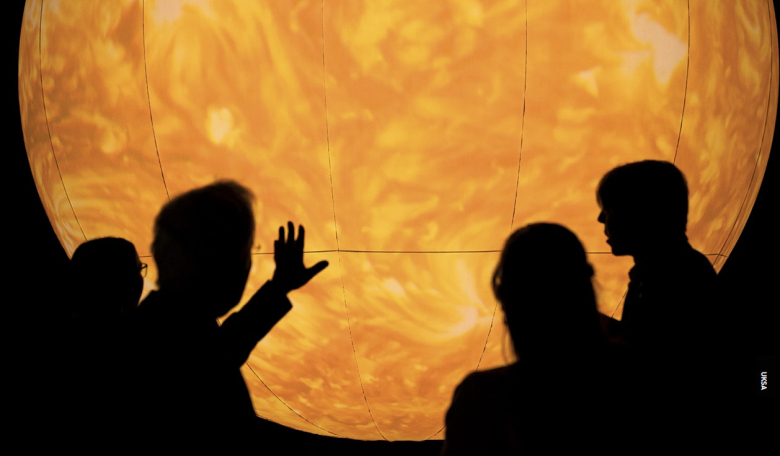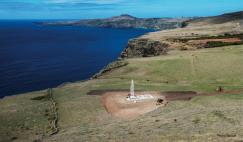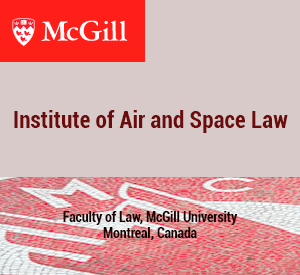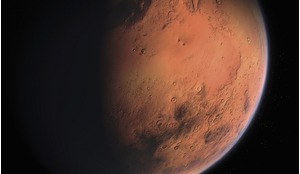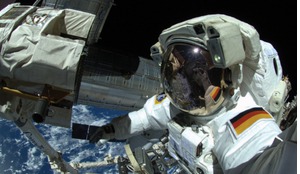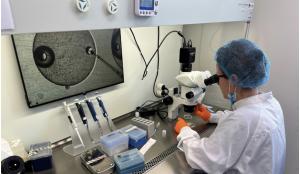With a final funding green light anticipated at the European Space Agency’s Ministerial meeting this November, Europe stands poised to launch its most ambitious space weather mission yet. Vigil will monitor space weather from the Lagrange Point L5 and promises to revolutionise how we detect, respond to and enhance global resilience in the face of increasingly volatile space weather events.
In an era of deep interdependence between space-based assets and terrestrial infrastructure, Vigil is more than a mission – it is an insurance policy for a technology-reliant world. “Extreme space weather is one of the most serious but least understood natural threats to our critical systems,” said Giuseppe Mandorlo, ESA’s Vigil project manager, speaking at the UK Space Conference (UKSC) in Manchester in July. “Vigil will give us a new, much-needed vantage point on the Sun, enabling timely and accurate warnings before storms strike.”
 Main participants in the Vigil briefing during UKSC 2025. Pictured (from left): Harshbir Sangha, director of missions and capabilities, UKSA; Giuseppe Mandorlo, ESA project manager; Tim Peake, UK former ESA astronaut; Denis Bensoussan, head of space, Beazley; and Dr Michelle Sprake, lead systems engineer, Airbus. Photo: UKSA/Max Alexander
Main participants in the Vigil briefing during UKSC 2025. Pictured (from left): Harshbir Sangha, director of missions and capabilities, UKSA; Giuseppe Mandorlo, ESA project manager; Tim Peake, UK former ESA astronaut; Denis Bensoussan, head of space, Beazley; and Dr Michelle Sprake, lead systems engineer, Airbus. Photo: UKSA/Max Alexander
L5 advantage
Vigil’s strategic position at the L5 Lagrange point, 60 degrees behind Earth in its orbit around the Sun, offers a unique view of solar activity before it becomes Earth-facing.
“Think of it as watching an arrow from the side, rather than waiting for it to hit you,” said Mandorlo. “At L1, current US satellites see solar material coming straight toward them – it’s hard to gauge speed and direction accurately. Vigil will change that by providing lateral perspective and continuous imaging.”
Vigil is more than a mission – it is an insurance policy for a technology-reliant world
By observing the evolution of active sunspot regions as they rotate toward the Earth-facing side of the Sun, Vigil will add a vital four- to five-day lead time for potentially hazardous space weather. Equally critical is its role in tracking coronal mass ejections (CMEs) in real-time after they erupt, enabling more accurate estimations of impact time, location and intensity.
This will enable a critical leap in both forecasting and ‘nowcasting’ – improving the lead time and accuracy of warnings for CMEs, solar flares and other solar phenomena that can disrupt satellites, navigation systems, power grids, aviation and communications.
Riding a storm
What makes Vigil different from past missions is its operational nature. Unlike science-focused missions, Vigil is built for durability and responsiveness. “It’s a weather station that has to work during a hurricane,” said Mandorlo. “The satellite must withstand the very solar storms it is monitoring – with robust radiation shielding, fault tolerance and 24/7 data relay infrastructure.”
These requirements include strict data latency requirements to ensure rapid turnaround from observation to alert. ESA is also developing a low-latency ground segment to receive, process and disseminate data within minutes. “The objective is to get high-fidelity, real-time insights into the hands of end users – satellite operators, grid managers, aviation controllers – so they can act fast,” said Alexi Glover, ESA’s Space Weather Service Coordinator.
Mandorlo and the other mission leads stressed that Vigil will not operate in isolation. Its data will be fused with that from L1-based satellites operated by NOAA and NASA, allowing for stereoscopic imaging of CMEs and greater forecasting fidelity. “This cooperation is essential,” said Glover. “The more vantage points and the more real-time data we have, the more reliable and granular our models become.”
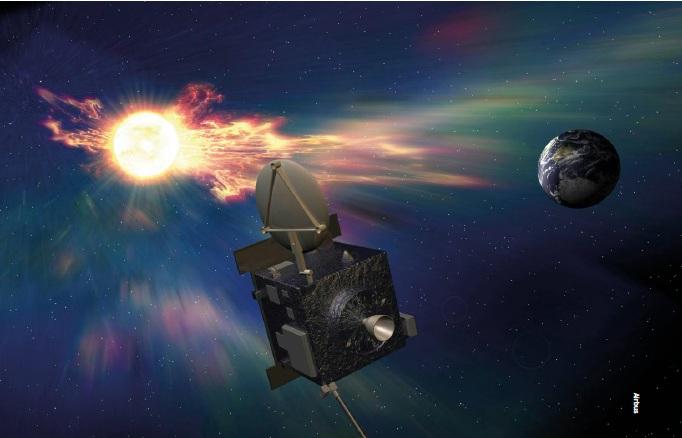 ESA selected Airbus as prime contractor for Vigil in the spring of 2024.
ESA selected Airbus as prime contractor for Vigil in the spring of 2024.
Precision toolkit
What makes Vigil different from past missions is its operational nature. Unlike science-focused missions, Vigil is built for durability and responsiveness
Vigil’s payload is a carefully selected suite of six instruments – four imagers and two in situ sensors – specifically designed to exploit its L5 orbit.
The UK’s contribution includes two key instruments: a plasma analyser built by the Mullard Space Science Laboratory and a magnetometer developed at Imperial College London.
Together, they will characterise the speed, density and magnetic properties of solar wind streams as they pass L5 – typically reaching Earth four or five days after leaving the Sun. These observations offer early warnings of potential spacecraft charging and geomagnetic storm conditions.
On the imaging front, the Vigil spacecraft will carry:
JEDI (Extreme Ultraviolet Imager) – developed by the Southwest Research Institute (US), it will monitor the middle solar corona for early signs of flare or CME activity
Compact Coronagraph – built by the US Naval Research Laboratory for NOAA, this camera will track CMEs from their eruption up to 20 solar radii
Heliospheric Imager – developed by Leonardo in Italy, it will follow CMEs further as they travel toward Earth, helping calculate arrival time and impact severity with unprecedented accuracy
Photospheric Magnetograph – provided by MPS Institute in Germany, this instrument will observe the build-up of magnetic stress in solar active regions, aiding longer-term forecasting.
“Each instrument adds a layer of foresight,” said Michelle Sprake, the engineer who will oversee spacecraft integration for prime contractor Airbus Defence and Space. “Together, they deliver a powerful blend of early warning and real-time monitoring – forecasting and nowcasting hand-in-hand.”
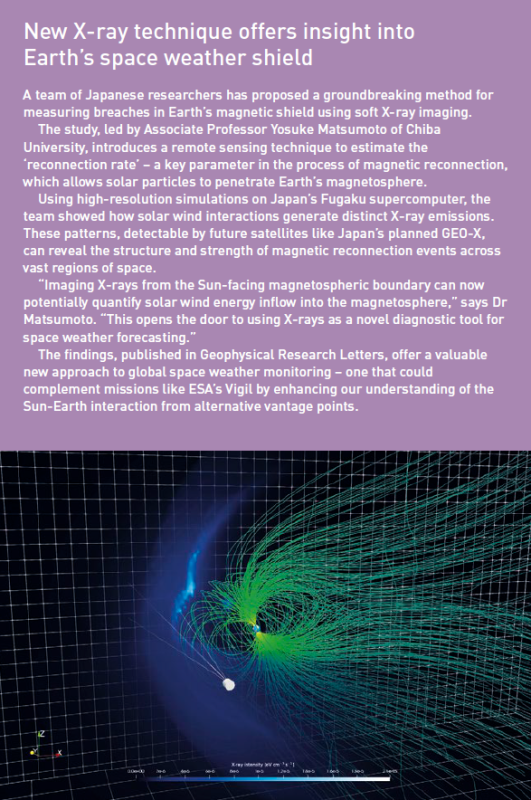 ESA selected Airbus as prime contractor for Vigil in the spring of 2024.
ESA selected Airbus as prime contractor for Vigil in the spring of 2024.
High risk stakes
ESA is also developing a low-latency ground segment to receive, process and disseminate data within minutes
The importance of Vigil is underscored by rising awareness of space weather as a systemic risk to modern day infrastructure and power systems. In March 2025, Lloyd’s of London hosted a high-level briefing on extreme space weather, citing its specially commissioned Marsh McLennan report that estimates a global economic loss of US$2.4 trillion over five years from a severe solar event [see ‘Life in the Sun’s atmosphere - the looming threat of solar storms’, ROOM Space Journal, Spring 2025, #36].
“This is not just a space problem,” said Denis Bensoussan of Beazley Insurance, who was a member of the media panel at the UKSC briefing. “Space weather affects aviation, energy, finance, supply chains and communications. And like climate risk, it’s not a matter of if – but when.”
The UK government is among those that already recognise space weather on its National Risk Register and Harshbir Sangha, representing the UK Space Agency (UKSA), emphasised that a ‘Carrington-level’ event today could cost the UK alone over £1 billion per day in lost Global Navigation Satellite System (GNSS) services. “We’re investing £160 million in Vigil because resilience starts with foresight – and right now we are flying blind,” he said.
Vigil will not prevent solar storms – but it can add to the warning time to mitigate their worst effects. Grid operators would have more time to reroute power, airlines could adjust flight paths and satellites could be placed in safe mode. “It’s about maximising the warning period,” said Mandorlo. “Sometimes the best action is simply knowing what not to do.”
Bridging the gap
“The next big event could be tomorrow or in five years. But when it comes, a mission like Vigil will make the difference between surprise and preparedness”
One growing concern is the aging state of current solar monitoring infrastructure. The joint NASA-ESA Solar and Heliospheric Observatory mission (SOHO) and NASA STEREO missions are operating well beyond their design lifetimes. While NOAA’s GOES and upcoming Space Weather Follow On (SWFO) missions will partially fill the gap, Vigil’s L5 perspective remains unique.
“The science community is worried,” commented Matthew West, ESA’s Vigil mission scientist. “We’ve already seen events where existing forecasts were off by a day. Getting data down to around two hours would be a game-changer.”
A new data source will also benefit science. “Though Vigil will be an operational system, we are flying science-grade instruments,” added West. “Everything we learn will feed into better models, better physics, and better preparedness.”
Yet Vigil’s timeline is by no means guaranteed. While ESA has completed preliminary instrument development with Airbus Defence and Space, full-scale build and launch preparations hinge on final funding commitments at this November’s ESA Ministerial meeting. A currently proposed dual payload rocket launch would see Vigil launched in 2031, taking 44 months to cruise to L5. A dedicated launcher could accelerate that to 12-14 months.
“We’re ready to go,” added Mandorlo. “The technical case is strong. The economic case is stronger. We just need the final political commitment.”
Once operational, Vigil will feed into Europe’s space weather services and complement national forecasting centres such as the UK Met Office and Météo-France, which provide 24/7 alerts to government departments and critical infrastructure operators.
Vigil also represents the initial phase of a shift toward a persistent, multi-spacecraft space weather monitoring system. “Vigil-1 is the first step,” said Mandorlo. “Ultimately, we envision follow-on missions at L5 and L1, ensuring seamless coverage. The goal is a global capability – built on cooperation, shared data and continuous observation.”
 Illustration showing the potential effects of adverse space weather on ground and space systems infrastructure.
Illustration showing the potential effects of adverse space weather on ground and space systems infrastructure.
Investment in resilience
In a world ever more dependent on space-based timing, navigation and communications, the requirement for reliable, early warning of space weather is no longer a luxury – it is more of a necessity.
“The Sun won’t wait for us to be ready,” concluded Mandorlo. “The next big event could be tomorrow or in five years. But when it comes, a mission like Vigil will make the difference between surprise and preparedness.”
If the ESA Ministerial meeting delivers in November, Europe will be on course to launch its first operational space weather sentry. The timescale may be drawn out but it will be a valuable step in the right direction towards greater global space resilience.





